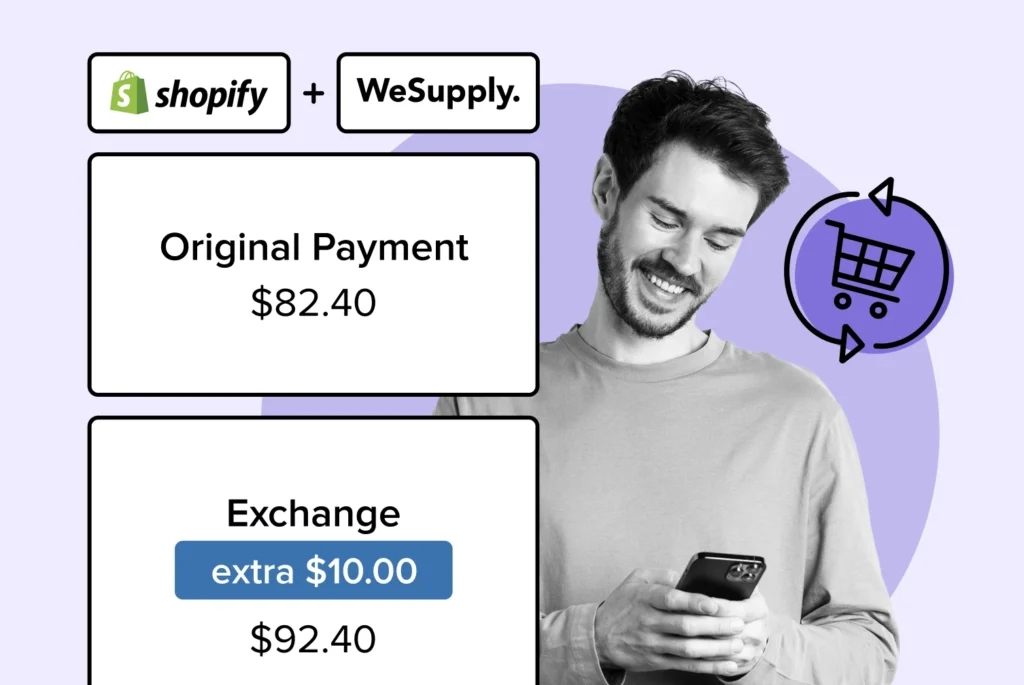
Ideal Return Window: What’s Best for Your eCommerce Store?
Dive into the nuances of crafting a return window that aligns with your brand, product categories, and customer expectations!
Shipping, Tracking & Notifications
Boost customer experience and reduce support tickets
Realtime order and shipment tracking
Proactive order and shipping notifications
AI-Enhanced Discounted Labels
Predictive pre-purchase estimated delivery dates
Self-Serivce branded order tracking
Effortless experience delivered
Identify and Resolve Order Issues
Realtime order and shipment tracking
Make returns profitable and delight customers
Flexibility to define any return destinations & conditions
Simplify returns for your customers and team
Incentivize exchanges over returns
Returns management made easy for your team
Returns management made easy for your team
Easy claims and smart upsells
Understand why your customers are returning
In-Store & Curbside Pickup
Unify the online and the in-store experience
Hassle-free pickup experience for customers
In-Store dashboard to keep operations streamlined
In-Store and Online orders unified
Drive foot-traffic to your stores
Shipping, Tracking & Notifications
Boost customer experience and reduce support tickets
Realtime order and shipment tracking
Proactive order and shipping notifications
AI-Enhanced Discounted Labels
Predictive pre-purchase estimated delivery dates
Self-Serivce branded order tracking
Effortless experience delivered
Identify and Resolve Order Issues
Realtime order and shipment tracking
Make returns profitable and delight customers
Flexibility to define any return destinations & conditions
Simplify returns for your customers and team
Incentivize exchanges over returns
Returns management made easy for your team
Returns management made easy for your team
Understand why your customers are returning
In-Store & Curbside Pickup
Unify the online and the in-store experience
Hassle-free pickup experience for customers
In-Store Dashboard to keep operations streamlined
In-Store and Online orders unified
Drive foot-traffic to your stores
Boost customer experience and reduce support tickets
Realtime order and shipment tracking
Proactive order and shipping notifications
AI-Enhanced Discounted Labels
Predictive pre-purchase estimated delivery dates
Self-Serivce branded order tracking
Effortless experience delivered
Make returns profitable and delight customers
Flexibility to define any return destinations & conditions
Simplify returns for your customers and team
Incentivize exchanges over returns
Returns management made easy for your team
Equip your team for precise return checks.
Easy claims and smart upsells
Understand why your customers are returning
Unify the online and the in-store experience
Hassle-free pickup experience for customers
In-Store Dashboard to keep operations streamlined
In-Store and Online orders unified
Drive foot-traffic to your stores
Find the answer to all your questions
Take a step by step trip through our functionality to see how we can improve your ecommerce processes.
Explore the most comon questions about WeSupply
Calculate the ROI that WeSupply can bring you
Read actionable articles on how to optimize your post-purchase experience and decrease support tickets
Get inspired by stories of how our customers implemented an effortless post-purchase experience
Wondering if WeSupply is a good fit for you? Read through our use cases to see how we can help you increase conversion & improve CX!
A Deep Dive into Top Companies' Order Tracking & Returns Strategy
Find the answer to all your questions
Explore the most comon questions about WeSupply
Calculate the ROI that WeSupply can bring you
Request a no strings attached review of your current shopping experience and missed conversion opportunities
Take a step by step trip through our functionality to see how we can improve your ecommerce processes.
Read actionable articles on how to optimize your post-purchase experience and decrease support tickets
Get inspired by stories of how our customers implemented an effortless post-purchase experience
A Deep Dive into Top Companies' Order Tracking & Returns Strategy
Wondering if WeSupply is a good fit for you? Read through our use cases to see how we can help you increase conversion & improve CX!

Need to return an item and wondering if you can? We get it, return eligibility rules can be confusing. Let’s clear that up. In this guide, we dive into the nitty-gritty – when returns are accepted, what conditions your items need to meet, and how to set up a policy that’s straightforward for everyone involved.
Return eligibility rules are paramount for customer trust and fraud prevention, and they require specific conditions for returns, particularly in tax-related businesses.
An effective return policy depends on factors like clearly defined time frames for returns, who covers return shipping costs, charging restocking fees, and designating non-returnable items due to hygiene or safety.
Return policies should be implemented and continually enforced through clear communication with customers, staff training, and the use of technology solutions to automate the return process.
WeSupply offers a versatile return management solution for e-commerce, featuring customizable policies, extended exchange options, and strategic restocking fees. It efficiently manages shipping costs and automates return processes, while clearly identifying non-returnable items like sale goods, personalized products, and digital items. This comprehensive approach optimizes customer satisfaction, controls costs, and minimizes return abuse, striking a balance between flexibility and profitability. Ready to optimize your returns? Get Started with WeSupply now and redefine your return process.
Clear and fair return policies are equally important as high-quality products or services for a strong customer relationship. This fosters a positive customer experience and enhances customer loyalty, especially when dealing with products or services related to federal income tax. Furthermore, well-defined return eligibility rules streamline the return process, ensuring a smooth experience for customers with different filing statuses.
Prevention of fraud is another critical function of clear eligibility rules. By setting specific conditions for returns, businesses can reduce opportunities for return abuse. This is particularly important when dealing with products or services related to gross income calculations. However, businesses that lack clearly defined return eligibility regulations could experience:
Reduced customer satisfaction
Decline in customer loyalty
Potential damage to the business’s reputation, especially in businesses dealing with tax refunds.
WeSupply enables e-commerce businesses to efficiently manage returns and reduce costs through smart, customizable policies. Its system automates complex return processes, including handling final sale items and setting return window lengths. The built-in policy enforcer streamlines operations by automatically approving, rejecting, or flagging returns, emphasizing the importance of clear return eligibility rules in e-commerce.
Customer grievances about return policies often revolve around concerns such as:
being charged for return shipping
inadequate communication from the company
unjustified denial of return requests
delays in processing refunds
These concerns are particularly relevant when dealing with federal tax return-related products or services, such as the child tax credit, which is an important aspect of filing a federal tax return and determining your filing status, including married filing jointly, and calculating your net earnings. If you owe taxes, it’s crucial to address these concerns in a timely manner to ensure a smooth tax refund process.
Customer retention rates can be positively impacted by a well-defined return policy. It meets customer expectations, shows concern for customer satisfaction post-purchase, and improves the overall user experience, ultimately leading to higher revenue for the company. This is especially important for businesses that help customers file a tax return.
WeSupply focuses on using data-driven insights to enhance customer satisfaction in e-commerce. By tracking metrics like CSAT, NPS, and CES, it helps businesses refine their post-purchase experiences, ensuring clear and fair return policies. This approach fosters customer trust and loyalty, emphasizing the importance of understanding and adapting to customer needs. WeSupply transforms challenges into opportunities, ensuring a seamless and delightful experience for customers.
A smooth return process significantly depends on having clear eligibility guidelines. They provide clear instructions for returns, aid customers in understanding the necessary steps for refunds, and establish an effective system for managing returns, ultimately streamlining the process and minimizing customer perplexity. This is particularly important for businesses offering free tax filing services.
Instances of eligible returns require clear definition, including those specified in a Return and Refund Policy, which delineates the company’s procedures, guidelines, and specific criteria for accepting returns. A well-defined return process contributes to enhancing the overall customer experience by:
fostering trust and confidence in the brand
ensuring seamless and efficient returns
collecting valuable feedback
fortifying customer relationships through personalized assistance.
WeSupply streamlines the return process for e-commerce, reducing customer inquiries and enhancing policy compliance. It acts like a 24/7 support agent, guiding customers through returns or exchanges at any time. WeSupply provides clear instructions for attaching return labels and keeps customers updated with notifications on return status, delivery confirmations, and refund information. By clearly defining which items are eligible for return or exchange based on the store’s policy, WeSupply helps customers understand what they can and cannot return, leading to fewer ineligible returns and a smoother overall process.
Deceptive strategies employed by individuals constitute return fraud and abuse in retail. Some examples of these strategies include:
Purchasing or stealing items with the intention of defrauding the store
Engaging in price tag switching
Returning shoplifted items
Committing receipt fraud
Participating in shoplisting
Engaging in wardrobing
These strategies are also applicable to products or services related to railroad retirement tax, archer medical savings account, and other tax favored account.
Interestingly, return fraud is more prevalent in online retail compared to brick-and-mortar stores. This is also true for products or services related to tax credits, where customers may attempt to take advantage of return policies, especially when it comes to claiming premium tax credit.
WeSupply’s fraud prevention system is designed to safeguard businesses from return abuse. It recognizes and automatically blocks customers attempting to exploit return policies, such as those purchasing products for one-time use or without intention to keep. Additionally, WeSupply can sync with existing block lists to prevent certain customers from making returns. This system enables businesses to configure detection methods and outcomes, effectively reducing the returns fraud rate. By ensuring that refunds are not issued for non-returnable items, WeSupply maintains the integrity of return processes, protecting the interests of trusted clients and the business alike.
Crafting an efficient return policy requires careful consideration of several key elements. From defining the time frame within which returns are accepted to identifying items that cannot be returned due to hygiene, safety, or other reasons, each element has its own significance. This helps in building customer trust, setting expectations, and reducing losses especially when dealing with products or services related to unearned income.
Deciding who bears the cost of return shipping is another facet of an effective return policy. While some businesses might opt to charge customers for this, others may cover the shipping costs in a bid to uphold the customer relationship. Similarly, restocking fees are another factor to consider. While they may be seen as an extra charge by customers, they can also serve as a deterrent for customers who might otherwise exploit the return policy.
To avoid confusion and disputes, non-returnable items should be clearly listed. For instance, items such as mattresses, health and personal care products with damaged safety protection seals, and consumable goods are often designated as non-returnable.
Any return policy’s crucial aspect is the return window, the time frame within which returns are accepted. The typical timeframe for product returns in the majority of businesses varies from 14 to 60 days after the purchase date. Companies establish their return window by clearly articulating the duration and its calculation method, thereby providing customers with sufficient time to assess and appraise the product.
A company can effectively communicate its return window by:
Prioritizing transparency and honesty
Ensuring easy access to the return policy on the website
Maintaining an easily updatable policy that is consistently communicated throughout the customer journey
This is especially important for businesses dealing with products or services related to owing taxes. Return windows play a crucial role in enhancing customer satisfaction and fostering trust by providing customers with a specified period for product returns. Furthermore, they contribute to streamlining business operations by offering valuable insights for improvement.
WeSupply allows you to customize your return policy, to consider incorporating key features like brand/vendor-specific return windows, flexibility for exchanges after the return window, and extended holiday return periods. When developing your return policy, consider these essential features:
Brand/Vendor Specific Return Windows: Adjust return windows for each brand, balancing flexibility with manufacturer guidelines, especially for seasonal items.
Another key element in crafting a return policy is determining who bears the cost of return shipping. The allocation of return shipping expenses in the e-commerce industry can be determined through various approaches. Brands may opt to charge customers for return shipping to manage costs, while others may provide free return shipping. Typically, the allocation of these expenses is linked to the reason for return, with sellers frequently covering the costs for damaged, faulty, or misrepresented items.
While there are no federal regulations in the U.S. that dictate store obligations for accepting consumer returns or determining the party responsible for return shipping costs, these regulations may differ across states. Presently, approximately 66% of online retailers have established policies that necessitate customers to cover the cost of return shipping. Typically, return shipping for online purchases incurs a cost ranging from $7.50 to $8, with potential variations based on the retailer’s policies and the nature of the returned item.
WeSupply’s strategy for managing shipping costs in returns includes the following key features:
Shipping Fee Based on Return Reason: Implement a dynamic policy where shipping fees for returns vary depending on the reason. Charge for returns due to reasons like ordering the wrong size, but offer free returns for issues such as damaged items or late deliveries.
Waive Return Fee for Damaged Products: Improve customer satisfaction by waiving return fees for damaged products. This policy simplifies the return process and meets customer expectations for fairness and consideration.
Explore how WeSupply can optimize your return process and save on shipping costs. Ready to see the difference? Book a Demo today and elevate your customer experience.
Additional costs imposed on customers who return products by online stores are referred to as restocking fees. These fees are permissible if they are transparently communicated and are waived if the return is prompted by a defect or mistake on the retailer’s end.
Restocking fees can have a significant impact on customer purchasing decisions. Here are some potential consequences of high restocking fees:
Deter customers from making a purchase
Result in a reduced conversion rate
Complicate the return process
Decrease customer satisfaction
It is important for businesses to carefully consider their restocking fee policies to avoid these negative outcomes.
WeSupply aids businesses in managing return costs by implementing restocking fees for specific products. This strategy balances customer service with revenue management, applying fees based on SKU numbers for precise control. Charging restocking fees helps deter unnecessary returns, recovers costs associated with restocking, and maintains profitability. By carefully selecting which products incur these fees, WeSupply ensures businesses avoid financial strain and supports their sustainability in the competitive market.
Create custom return policies
There are many moving pieces in ecommerce logistics. Take control by creating custom policies to handle them all easily. You get to decide how you want to handle final sale items, return window lengths, return request approvals, and more.
Due to hygiene and safety concerns, certain items are often designated as non-returnable. These may include:
Items with compromised safety protection seals
Health and personal care products
Items deemed as health hazards or presenting safety risks based on their contents or components
Please note that these items are often non-returnable for the safety and well-being of our customers.
Apart from safety and hygiene concerns, other factors such as the nature of the product, the condition of the product, or the timing of the return also contribute to items being classified as non-returnable. To effectively communicate their policy on non-returnable items, businesses can:
Prioritize customer interests
Clearly state the terms and conditions
Ensure easy accessibility to refund policies on the business’s website, purchase confirmation emails, or receipts.
WeSupply assists in identifying non-returnable items for various reasons, including hygiene, safety, or sale conditions. Key features of their policy include:
Discover the efficiency and clarity of WeSupply’s return policies for your business. Ready to streamline your process? Get Started with WeSupply now and transform your return management strategy.
Return eligibility rules can be broadly divided into four categories:
1. Order-level conditions: These are the specific conditions that an order must satisfy to be considered eligible for a return request.
2. Customer-level conditions: These are the specific criteria that determine which customers are eligible to return a product.
3. Item-level conditions: These are the specific conditions that an item must satisfy to be considered eligible for a return request.
4. RMA-level conditions: These are the specific conditions that an RMA (Return Merchandise Authorization) must satisfy to be considered eligible for a return request.
Item-level conditions in return eligibility rules refer to the return policy rule properties that specifically determine the eligibility of individual items within an order for return.
Lastly, RMA-level (Return Merchandise Authorization) refers to the procedure through which a customer is required to acquire an RMA number from a merchant to initiate a product return. This number serves as a means to monitor the return process, and the customer is expected to furnish proof of purchase, such as a receipt, to qualify for an RMA.
Aspects like the return window and order creation date are the focus of order-level conditions. The return window is a defined period during which a customer can initiate a return, usually commencing from the order creation date. For instance, with a 90-day return window, the return must be initiated within 90 days from the order creation date.
Different payment types may have restrictions for refunds, particularly if the returns are conducted without a receipt. The specific limitations can differ by merchant and may also be subject to state laws. Furthermore, the order status, whether it is ‘delivered’, ‘in transit’, or ‘pending’, plays a crucial role in determining the commencement of the return eligibility period.
Assisting in determining a customer’s return request eligibility, customer-level conditions significantly contribute to return eligibility rules. These conditions, including time limits for returns, also contribute to the management of business cash flow and help in establishing clear expectations for customers regarding product returns.
The location of a customer can have an impact on return eligibility by influencing the availability of return options and the ease of returning items. A customer’s purchase history can be leveraged to assess return eligibility by using it as a basis to validate product condition, check purchase details, and generate necessary documentation for the return process.
Furthermore, previous return requests by a customer can have an impact on their return eligibility by influencing the acceptability of conditions and determining whether a return can be processed.
Specific criteria that an item must meet to qualify for a return are referred to as item-level conditions. For instance, due to hygiene and safety reasons, some retailers may not accept returns of face and body products. Certain return policies may contain eligibility criteria that restrict returns to items below a specific price. Additionally, the combined listed price of all items being returned can also impact return eligibility.
Imposing restrictions on the frequency of item returns can impact the eligibility of items for return. Rules regarding item eligibility can be established to restrict the return of items based on the frequency of returns. Furthermore, items may be classified as non-returnable in certain industries due to factors such as the nature of the product (e.g., digital items, unsafe products), the condition of the product, or the timing of the return.
Item-level conditions within return policies typically mandate that returned items must be:
in their original condition
complete with all accessories and packaging
unworn
inclusive of all items originally listed.
The return requests themselves are governed by RMA-level (Return Merchandise Authorization) conditions. A Return Merchandise Authorization (RMA) is a numbered authorization provided by a mail-order or e-commerce merchant to allow the return of a product. It is a system put in place by businesses to effectively handle and facilitate returns and exchanges.
Typical conditions related to return requests in a retail return policy encompass:
Items being returned due to unmet expectations
Damaged or defective products
Incorrect fit
Requirement for the item to have its original packaging or tags
Limitations on which items can or cannot be returned
The regulations governing the number of items that can be returned at once in an RMA policy are typically set by the merchant and usually involve the customer contacting the company to request an RMA number. The specifics of these regulations may vary between different companies.
Lastly, RMA-level conditions contribute to the management of returns by:
Facilitating the initiation of returns
Determining outcomes such as refunds or exchanges
Tracking returned items
Managing inventory levels
Enabling strategic planning for returns.
Effective implementation and enforcement are the next steps after defining the return policy and eligibility rules. This involves:
Clear communication of the policy to customers
Comprehensive staff training
Utilization of technology solutions to manage and automate the return process.
A positive shopping experience requires customers to understand the return policy. Therefore, it’s important to clearly convey the return policy to customers through various channels like the company’s website, during the checkout process, and within order communications to ensure maximum understanding and compliance.
In the implementation and enforcement of a return policy, staff training is of utmost importance. to guarantee that employees are thoroughly knowledgeable about the most recent refund policies, procedures, and eligibility criteria, thereby enabling consistent and effective management of returns.
Technology significantly streamlines the return process for both the business and the customer. This is achieved through the automation and management of return operations using tools such as:
Reverse logistics supply chain management software
Returns automation
RMA authorization
Barcode scanning
Data capture
Real-time tracking systems
Preventing misunderstandings when communicating return policies to customers requires clear communication. It entails clearly defining and conveying return eligibility, ensuring that refund policies are readily accessible and comprehensible. This helps customers understand their rights and obligations, ultimately minimizing disputes.
Best practices for effectively communicating return policies on a website include formalizing the policy, clearly explaining if returns and refunds are accepted, outlining the conditions for eligibility, and indicating any items that are final sale. Similarly, the recommended best practices for communicating return policies via email include providing clear information on eligible products and conditions, offering contact details for inquiries, providing options for return initiation, conducting data analysis on returns, and ensuring the use of clear, concise, personalized, and timely responses.
Lastly, the most effective in-store signage for conveying return policies is informational signs that provide detailed store policies, including return and exchange policies.
WeSupply’s Branded Returns Portal empowers merchants to showcase their return policies transparently to customers seeking to initiate returns or exchanges. This feature ensures that businesses can provide clear and accessible information, enhancing the overall customer experience and streamlining the return process.
It is crucial to provide staff training for handling return policies. as it ensures that staff members are well-versed in the policies, eligibility criteria, and procedures for returns and exchanges. This leads to consistent and efficient handling of returns, ultimately resulting in heightened productivity and improved customer satisfaction.
The most effective strategy for educating staff about return policies is to:
1. Offer continuous training and refresher courses to ensure that employees are well-versed in the latest refund policies and procedures.
2. Foster open communication and provide feedback and evaluations to the staff members responsible for handling returns.
3. Utilize a uniform training approach to equip all employees with the essential knowledge and skills required to comply with the return policy.
This approach aids in reducing errors, upholding consistency in managing returns, and enhancing customer satisfaction.
Lastly, while there is no specific frequency mentioned, ongoing training is recommended to ensure maximum efficiency and a positive return on investment. Conducting multiple training sessions over time can help employees become more knowledgeable and empowered.
Automating and managing the return process is facilitated by technology solutions like WeSupply, making it more efficient and accurate. Essential features of a high-quality return management software include:
A customer portal for self-service
RMA (Return Merchandise Authorization) management for monitoring and processing returns
Business intelligence for analyzing return patterns
Automated communications to keep customers informed
A user-friendly interface to enhance usability for all users
Automation capabilities to minimize manual work
Integration with existing eCommerce platforms for a seamless operation.
Just like in the case of Evereve, a leading fashion retailer with boutiques and an online presence, the challenge of handling returns efficiently was evident. Their manual and disjointed process lacked visibility into returns, resulting in markdowns and overwhelmed customer service teams. Evereve aimed to simplify returns and leverage them as an opportunity for increased sales and customer loyalty. By collaborating with WeSupply and integrating their technology, they automated the return process and prioritized proactivity, self-service, and return flexibility. This strategic shift resulted in cost savings, quicker and more accurate returns, and an improved customer experience, benefiting both the business and its customers. Eager to explore Evereve’s return success story? Read the full case study and discover how they transformed their returns into opportunities with WeSupply.
Combat inconvenience with proactivity & self service
Book a quick call with our experts to see how WeSupply can help you make returns easy for your customers with a beautiful, self-service solution that makes their experience easier while also providing new ways to lower costs and earn back revenue.
In conclusion, a well-crafted return policy is an important aspect of customer satisfaction, operational efficiency, and fraud prevention. Every business needs to define its return eligibility rules, which include order-level, customer-level, item-level, and RMA-level conditions. Clear communication of these rules, efficient staff training, and the use of technology solutions can ensure successful implementation and enforcement of the return policy.
WeSupply streamlines return management for e-commerce businesses with a comprehensive set of features. It allows customizable return policies for different brands and vendors, extends exchange periods, and implements restocking fees for selected SKUs to control return costs. The platform manages shipping costs efficiently, offering free returns for exchanges and varying fees based on return reasons. Its policy enforcer automates complex return processes, and a well-defined strategy for non-returnable items covers sale items, personalized products, specific SKUs, highly discounted items, used goods, and digital products. WeSupply balances customer satisfaction with profitability, effectively reducing fraud and return abuse in the process.
WeSupply provides a robust platform for tailoring return policies to meet your specific needs. You can create brand/vendor-specific return windows, extend exchange options, and implement restocking fees for selected products.
WeSupply efficiently manages shipping costs by offering features like free return shipping for exchanges and variable fees based on return reasons, ensuring cost-effectiveness while satisfying customer needs.
Yes, WeSupply’s policy enforcer automates return approvals, rejections, or manual reviews, streamlining even the most intricate return policies.
WeSupply has a comprehensive strategy for non-returnable items, including sale items, personalized products, specific SKUs, highly discounted items, used goods, and digital products. It ensures that these items are clearly identified and ineligible for return.
Ready to enhance your return policy? Get Started with WeSupply today and redefine your return process with these advanced features.

Learn How To Create Successful Post Purchase Email Campaigns
Build an effective post-purchase email flow that helps you increase customer satisfaction and drive revenue growth!

Dive into the nuances of crafting a return window that aligns with your brand, product categories, and customer expectations!

Explore the 12 key benefits that illustrate why emphasizing exchanges over refunds can be a transformative strategy for your online store!

A clear breakdown of return types, their strategic advantages, and how they contribute to customer loyalty and revenue—crucial insights!

Balance your rights as a seller with customer care, leading to a seamless return experience that promotes loyalty and protects your business.

Learn how one-click exchanges function, and practical steps to integrate them smoothly into your eCommerce setup!

Cut through the fluff with direct insights into powerful incentives, streamlined processes, and technological enhancements!

Bonus credit system: transform returns into future sales, enhance customer satisfaction, and ultimately contribute to a stronger bottom line.

Simplify the return process for both businesses and customers: the functionalities and benefits of an e-commerce returns exchange portal.

Maximize revenue through intelligent exchange policies and practices: transform a simple exchange into a powerful retention tool.